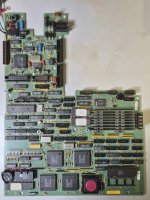I have several GRiD computers—most of them work, but some are dead. I’ll discuss two of them here, as they have a similar problem.
The first is a GRiDCase 1520 LCD with eight 256K RAM SIPPs. It’s in excellent physical condition, but it doesn’t boot. It beeps 1-3-3, which, according to the service documentation, means:
"1st 64K RAM chip or data line failure - multiple bit." I tested all the SIPP modules in my RAM tester, and they passed every test, even under marginal conditions (voltage/timing variations). I also tried using different, known-good SIPPs, but the computer still behaves the same way. On the mainboard, next to the FPU and CPU, there’s a 40-pin IC marked "RAMC286". I swapped it with one from another working GRiD I own. It wasn’t the exact same chip, but the result was unchanged. I’m unsure if that was due to the difference in chips or if the real issue lies elsewhere on the board. According to GRiD’s documentation, at least two versions of this chip exist—one supports only 256K modules, while the other supports both 256K and 1MB modules. I took a bit of a risk installing a different one, but it didn’t damage the chip—after putting it back in the working computer, it still functions fine. So, the real issue in this 1520 likely lies elsewhere on the motherboard. This has been an unresolved problem for nearly two years now.
So, the real issue in this 1520 likely lies elsewhere on the motherboard. This has been an unresolved problem for nearly two years now.
The second machine – GRiDCase 1530
Strangely, I recently acquired another GRiD with a similar issue. I bought a GRiDCase 1530 on eBay—an incomplete, dirty unit—because I noticed it had a 15-pin VGA connector instead of the usual 9-pin CGA. I wanted it just for its VGA card and LCD, but once I had it in my hands, I realized it wasn’t a lost cause. It’s missing some components—specifically, the entire rear top magnesium cover, the HDD/floppy module, and the PSU module—but otherwise, it’s intact. I thought I might be able to get it running using parts from other non-working GRiDs. A VGA-equipped 1530 would be great to have. However, it has the exact same problem as the 1520—it beeps 1-3-3 at boot. Once again, all SIPPs test good, and swapping in known-good modules made no difference. I know I can still use the VGA card and LCD in another GRiD originally built for CGA (as was my original plan), but now I really want to get this 1530 motherboard running!
I’ve collected maybe six or seven GRiDCase 1520s and 1530s over the years, and two of them arrived dead with the same 1-3-3 beep issue. Both were listed as "untested", of course. Has anyone seen this issue with these boards before? Any help would be much appreciated!
Has anyone seen this issue with these boards before? Any help would be much appreciated!
The first is a GRiDCase 1520 LCD with eight 256K RAM SIPPs. It’s in excellent physical condition, but it doesn’t boot. It beeps 1-3-3, which, according to the service documentation, means:
"1st 64K RAM chip or data line failure - multiple bit." I tested all the SIPP modules in my RAM tester, and they passed every test, even under marginal conditions (voltage/timing variations). I also tried using different, known-good SIPPs, but the computer still behaves the same way. On the mainboard, next to the FPU and CPU, there’s a 40-pin IC marked "RAMC286". I swapped it with one from another working GRiD I own. It wasn’t the exact same chip, but the result was unchanged. I’m unsure if that was due to the difference in chips or if the real issue lies elsewhere on the board. According to GRiD’s documentation, at least two versions of this chip exist—one supports only 256K modules, while the other supports both 256K and 1MB modules. I took a bit of a risk installing a different one, but it didn’t damage the chip—after putting it back in the working computer, it still functions fine.
The second machine – GRiDCase 1530
Strangely, I recently acquired another GRiD with a similar issue. I bought a GRiDCase 1530 on eBay—an incomplete, dirty unit—because I noticed it had a 15-pin VGA connector instead of the usual 9-pin CGA. I wanted it just for its VGA card and LCD, but once I had it in my hands, I realized it wasn’t a lost cause. It’s missing some components—specifically, the entire rear top magnesium cover, the HDD/floppy module, and the PSU module—but otherwise, it’s intact. I thought I might be able to get it running using parts from other non-working GRiDs. A VGA-equipped 1530 would be great to have. However, it has the exact same problem as the 1520—it beeps 1-3-3 at boot. Once again, all SIPPs test good, and swapping in known-good modules made no difference. I know I can still use the VGA card and LCD in another GRiD originally built for CGA (as was my original plan), but now I really want to get this 1530 motherboard running!
I’ve collected maybe six or seven GRiDCase 1520s and 1530s over the years, and two of them arrived dead with the same 1-3-3 beep issue. Both were listed as "untested", of course.


